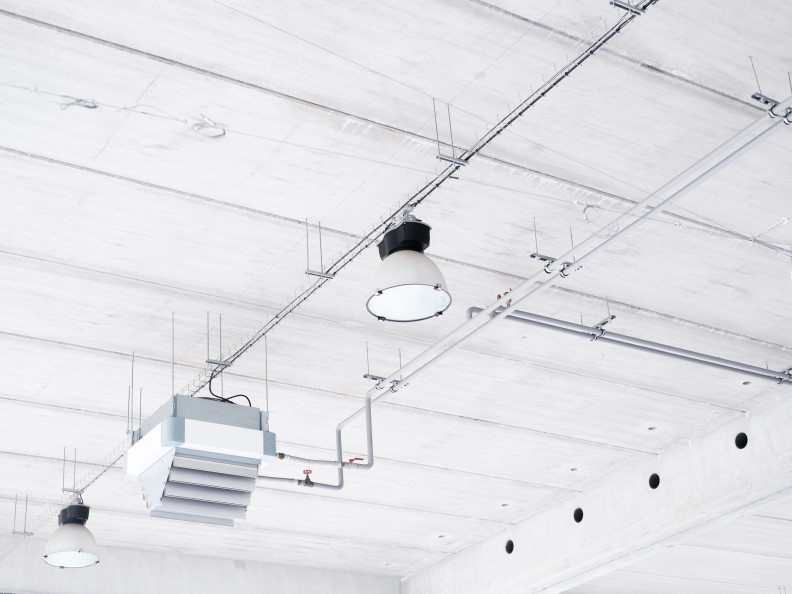Building owners benefit from having both energy efficiency and indoor air quality. While energy efficiency reduces operating costs, IAQ improves the built environment for occupants. There is a common misconception that you must choose between both benefits - many owners believe that air quality requires more energy, and that efficient ventilation reduces air quality. However, both aspects of building performance can be improved simultaneously, by understanding how they interact and making smart design decisions.
Two studies by the University of Reading and Chalmers University of Technology conclude that modern design standards from around the world have made buildings more airtight, and this impacts indoor air quality:
- The goal of airtightness is minimizing the exchange of outdoor and indoor air, keeping indoor temperatures stable and reducing the workload on heating and cooling systems.
- However, airtight buildings depend on mechanical ventilation with fans to keep an adequate supply of fresh air.
- When an energy efficient building suffers from poor air quality, it’s it normally due to deficient ventilation, and not a direct consequence of saving energy.
- The Chalmers University study found that efficient buildings with passive ventilation tend to suffer from low air quality, compared with conventional buildings. However, efficient buildings with smart mechanical ventilation often achieve better air quality than conventional buildings.
Both studies point out that ventilation performance is often analyzed based only on energy consumption, and meeting the minimum ventilation rates in local construction codes. They recommend an evaluation that also considers thermal comfort and air quality.
Ideally, a ventilation system should provide just the right airflow to keep pollutants under control, while avoiding overventilation and energy waste. This can be accomplished with smart controls, by adjusting the ventilation rate based on building needs, thermal comfort, air pollution or saving energy, in real time.

HVAC systems consume the most energy in commercial buildings, and they are also key for keeping a healthy iaq.
Types of Ventilation Systems and their Energy-Saving Potential
Depending on how they supply air, HVAC systems can be classified into constant air volume (CAV) and variable air volume (VAV).
- As implied by its name, a CAV system always provides the same airflow. This limits energy efficiency, since airflow cannot be reduced when the full capacity is not needed.
- VAV systems can ramp down ventilation rates, and they can achieve synergy with smart controls.
- VAV systems offer more flexibility when operating and a higher potential to save energy.
Since CAV systems are simpler, they have a lower upfront cost, assuming you compare the same fan capacity. However, the long-term operating cost of CAV systems is higher, since they have a limited potential to save energy. A VAV system can achieve better control over air quality while saving energy. A study by Çukurova University (Turkey) compared the costs of CAV and VAV for a school building and a commercial office:
- The upfront cost of a VAV system was 21% higher for the school building, and 23% higher for the office building. However, when lifetime costs were considered over a 15-year period, VAV is the least expensive option.
- In the school building, the VAV system lifetime cost was 3% lower if used 9 hours per day, and 11% lower if used 16 hours per day.
- For the office building, the VAV system lifetime cost was 3% lower with a 9-hour schedule, and 13% lower with a 16-hour schedule.
According to a study by the US Environmental Protection Agency, a VAV system can achieve annual energy savings of 10% to 21% compared with CAV. This represents cash savings of $0.10-$0.20 per square foot per year. Greater savings are possible in actual projects, since the study assumed a CAV system with above-average efficiency. The US EPA considered three building types (office, school and auditorium) and three climates (hot & humid, temperate and cold).
- 53,600 sq.ft.
- 3 floors
- 33% window fraction
- Office building
- The energy sources are electricity and gas
Moving from a CAV system to a VAV one would yield yearly energy savings of:
* savings calculated according to: area (sq. ft.) x cash savings of $0.10-$0.20 per square foot per year
CAV systems do not respond directly to indoor air quality, since they provide a constant airflow all the time. If the fans are properly sized for the space being ventilated, there should be no air quality issues. However, when air pollutant levels are low and the full airflow is not needed, a CAV system wastes energy by over-ventilating. While this configuration conserves air quality, energy is not used efficiently.
On the other hand, a VAV system can be ramped down in response to ventilation needs, which means it conserves air quality with less energy. However, smart automatic controls are fundamental when dealing with VAV - a poorly-configured system may reduce airflow too much, having a negative effect on air quality.
Boost productivity and worker satisfaction in your office while you keep energy bills small.
Learn more about what our Ai can do for you and your business here
Indoor Air Quality Is Also an Investment
Energy efficiency measures have a direct economic benefit, since they reduce operating costs. The economic benefit of indoor air quality is less obvious, but even more significant. A combined study by Harvard TH Chan School of Public Health, SUNY Upstate Medical University and Syracuse University analyzed how indoor environmental quality improves productivity:
- The participants in the study were 24 professionals from areas like architecture, engineering, marketing and management.
- When they worked under the conditions of an energy efficient building with enhanced ventilation, their decision-making performance improved by 61%.
This means that building owners can achieve important financial returns from improving the indoor environmental quality. Since occupants represent 90% of costs in buildings, businesses should provide conditions that maximize their well-being and productivity.
Balancing Indoor Air Quality and Energy Efficiency
In theory, you can over-ventilate a building 24/7 to prevent the accumulation of air pollutants, achieving a high level of IAQ. However, this drastically increases ventilation costs. Space heating and air conditioning costs also increase, since the HVAC equipment must handle a larger air volume. This is an example of indoor air quality at the expense of energy efficiency.

Opening windows is an example of a measure that might improve air pollution at the expense of energy efficiency.
The opposite approach is not recommended either. For instance, the building owner could reduce the ventilation rates and operating hours of the HVAC system. However, this would allow an increased accumulation of indoor air pollutants. Depending on where the building is located, an arbitrary reduction of heating, cooling and ventilation can also be against local codes. This is an example of energy savings at the expense of indoor air quality.
A well-designed HVAC system optimizes energy consumption and air quality, achieving synergy whenever possible.
- The ventilation rate can be increased or decreased based on air pollution levels, measured by a reliable monitoring system like Foobot.
- If local building codes establish a minimum ventilation rate, the control system can simply be configured to never reduce airflow below that value.
This operating mode offers just the right ventilation to keep air pollutants under control, without wasting energy with overventilation, and without going below the airflow rates required by codes.
Improving Energy Efficiency with Airside Economizers and Energy Recovery Ventilation
Airside economizers and energy recovery ventilation are two energy efficiency measures for HVAC systems, which also improve air quality under some conditions. However, the professional opinion of an energy consultant is recommended before installing these measures, since their effectiveness is reduced in some climates.
An airside economizer is a smart device that can determine when outdoor air has the same cooling effect as an air conditioner. In these cases, the economizer deactivates or ramps down air conditioning equipment, and the outdoor airflow is increased instead. As a result, the economizer saves energy on air conditioning, while improving air quality with higher airflow. However, economizers are ineffective with hot and humid climates, since the outdoor air is not suitable for “free cooling” most of the time. Economizers work best in temperate climates, or in the warmer months of cold climate zones.
A ventilation system should provide just the right airflow to keep pollutants under control, while avoiding overventilation and energy waste. This goal can be accomplished with smart controls.
The effectiveness of an airside economizer depends on the local climate, and how much the building uses air conditioning. According to the ENERGY STAR website, they typically reduce air conditioning costs by over 10%. In buildings such as data centers, which use air conditioning all year long, cooling savings of over 60% have been reported with airside economizers.
Energy recovery ventilation consists of exchanging heat and humidity between the supply air and the exhaust air of a ventilation system. This way, the HVAC system can control indoor temperature and humidity with a lower energy consumption.
- During summer, the indoor air is cooler. The exhaust airflow is used to pre-cool the outdoor air supply.
- On the other hand, the indoor air is warmer during winter. In this case, the exhaust airflow is used to pre-heat the outdoor air supply.
- According to a study by Pacific Northwest National Laboratory, an ERV system can typically reduce HVAC costs by around 10%. However, the exact performance will depend on the local climate and the building’s operating schedule, similar to airside economizers.
When only heat is exchanged, this system is called heat recovery ventilation. When humidity exchange is added, it is called enthalpy recovery ventilation.
- Consider that ASHRAE recommends a humidity range of 30% to 60%.
- When the outdoor air is too humid, the exhaust air can be used to remove part of this moisture.
- On the other hand, when outdoor air is too dry, the exhaust air can be used to provide moisture.
High humidity and low humidity are both detrimental for indoor air quality. High humidity creates a favorable environment for mold, dust mites and bacteria, and all have a negative impact on indoor environmental quality. On the other hand, low humidity causes pollutant particles and viruses to stay airborne longer, and it may also irritate the respiratory system. Since ERV improves humidity control, it contributes to both energy efficiency and IAQ.
The performance of airside economizers and ERV systems varies a lot depending on the local climate and the building’s usage. To get an accurate estimate of the potential savings, the best recommendation is simulating the building with energy modeling software. Operating schedules and the local climate are both used as inputs for the analysis, ensuring an accurate result.
Conclusion
There is a common but wrong idea that energy efficiency reduces indoor air quality. However, it would be more correct to say that air quality suffers due to poor design decisions. When an energy efficient building has air quality issues, it is often the result of insufficient ventilation. With smart ventilation controls, a building can achieve superior air quality while saving energy.
Energy efficiency and indoor air quality can both be considered investments. While energy efficiency measures reduce electricity and gas bills, a high level of air quality enhances tenant satisfaction as it produces health and productivity benefits for them.
Foobot’s Smart Air Building technology is the embodiment of a smart control system that improves both energy savings and indoor air quality that runs completely on its own.

Indoor comfort and energy savings on autopilot
Thermal comfort and indoor air quality are very correlated to staff health and cognitive performance, studies say.
Since human resources are businesses' largest expense, it's time to give them the best.
